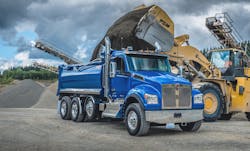AMT vs. AT: Spec'ing the right transmission for vocational trucks
This is Part 3 of series on automatic transmission. Read Part 1. Read Part 2.
The debate over whether to use an automatic manual transmissions or automatic transmission has become more complex as fleets try them in various applications. While AMTs still dominate the long haul segment, automatic transmissions have found a niche in certain short haul applications.
“They’re incredibly easy to use, with the smoothest shifting,” said Jim Nachtman, Heavy Duty Product Marketing Director for Navistar, which he cited as a reason International customers spec Allison’s 3000 Series transmission for regional beverage applications.
Vocational applications, though, are Allison’s strong suit, and the fully automatic brand has a significantly higher presence on International’s HV and HX Series.
Consider total cost of ownership when deciding between ATs and AMTs, advised Branden Harbin, managing director of global marketing at Allison Transmission. Unlike torque converters, clutches wear out. “So over time, whether it’s three years, five years on duty cycle, the fleet is incurring the maintenance cost of replacing the clutch,” he said. “And on work trucks, that downtime can be $1,000 to $8,000 a day, and the clutch replacement can take anywhere from one to three days.”
Daniel Mullins Trucking, which hauls rocks and sand, found that converting half of its 90 Peterbilt trucks to Allison greatly decreased its downtime with not one transmission incident among those trucks.
“We’re not doing clutch adjustments. We have less shock load incidents when we’re doing off-road work with the four axle dumps,” owner and president Danny Mullins said.
The biggest data point of all is that users aren’t shifting away. “We found that we have a 95% retention rate when the customer tries that product because they see the value,” Harbin said.
For certain vocational applications, where pulling 150,000 lbs. may be required, the manual transmission’s light still flickers. But even here, AMTs are beginning to shuffle in, as transmissions such as Mack’s mDrive HD and Volvo’s I-Shift have crawler gears to allow a steady slow pace—0.6 mph for the I-Shift— for pouring concrete, for example.
“Look for AMTs to become more prevalent in vocational applications,” said Kelly Gedert, director of product marketing for Freightliner and Detroit - Damiler TRucks North America. “The lightweight design, reliability, flexibility, and ease of use becomes more desired in vocational/off-highway applications.”
About the Author
John Hitch
Editor
John Hitch is the editor-in-chief of Fleet Maintenance, providing maintenance management and technicians with the the latest information on the tools and strategies to keep their fleets' commercial vehicles moving. He is based out of Cleveland, Ohio, and was previously senior editor for FleetOwner. He previously wrote about manufacturing and advanced technology for IndustryWeek and New Equipment Digest.

